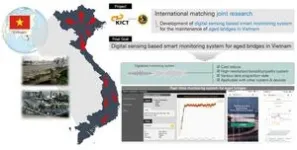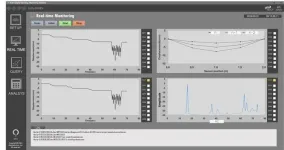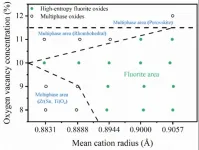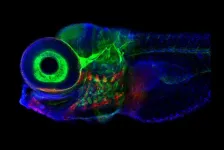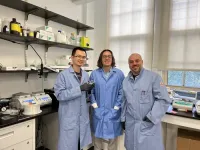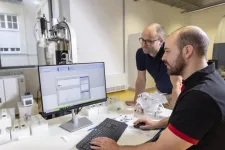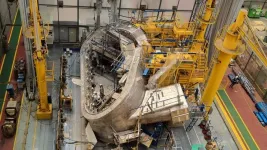(Press-News.org)
Hydrogen is becoming an increasingly popular choice as we shift towards cleaner energy. It can be burned like traditional fuels, producing only water as a byproduct, and can generate electricity when used in fuel cells. However, as hydrogen production, use, and transportation increase, so do safety concerns. Hydrogen is highly flammable at concentrations as low as 4% and is odorless and colorless, making leaks challenging to detect.
To address these concerns, researchers led by Professor Yutaka Majima from Institute of Science Tokyo (Science Tokyo) have developed a sensor that detects hydrogen at ultra-low concentrations with a very short response time. Their study was published in the journal Advanced Functional Materials on November 5, 2024.
The sensor is made from nano-patterned polycrystalline CuO NWs, which are highly sensitive to hydrogen gas, placed on a silicon (SiO2/Si) substrate with platinum/titanium electrodes. “We employed electron-beam lithography and two-step ex-situ oxidization to develop a reliable and reproducible process for preparing high-performance, nano-patterned CuO nanowire-nanogap hydrogen gas sensors with voids, which is considerably different from conventional free-standing single-crystal CuO nanowires directly grown from copper sources,” says Prof. Majima.
When exposed to hydrogen gas, the sensor operates by detecting changes in the electrical resistance of CuO NWs. In air, oxygen molecules attach to the surface of the CuO NWs, forming oxygen ions (O2⁻, O⁻, O22-) that induce a layer of positive charge carriers (holes) near the surface. When hydrogen is introduced, it reacts with the oxygen ions on the surface of the CuO NWs to form water, which lowers the hole concentration. As a result, the NWs become less conductive. By measuring the increase in resistance, the sensor can detect the presence and concentration of hydrogen gas.
The researchers enhanced the sensor's performance by introducing a pre-annealing step in a hydrogen-rich environment, followed by slow oxidation in dry air. Initially, the fabricated copper (Cu) NWs have low crystallinity and form a Cu oxide layer on the surface, hindering interaction with oxygen. The annealing process reshapes the Cu NWs from a rectangular to a semicircular arch form, improving their crystallinity. In the subsequent oxidation step, the Cu NWs are converted into copper oxide. During this process, copper atoms diffuse outward to react with oxygen, creating voids that increase the surface area of the NWs, providing more active sites for hydrogen and oxygen to interact with the NW.
As a result of these improvements, the sensor can detect hydrogen concentrations as low as 5 parts per billion (ppb), much lower than previous CuO-based H₂ sensors. Additionally, it is resistant to humidity, a common drawback of CuO gas sensors. The sensor also responds quickly, detecting hydrogen in just 7 seconds.
The researchers further enhanced the sensor’s performance by reducing the nanogap separation between the electrodes. A smaller gap generates a stronger electric field, accelerating the movement of charge carriers and speeding up the sensor’s response and recovery. With a gap size of 33 nm, the sensor detected 1,000 ppm of H₂ in just 5 seconds and returned to baseline conditions in 10 seconds. “We will continue developing a wider range of gas sensors with this process to fabricate sensors for other hazardous gases as well,” says Prof. Majima.
By early detection of leaks or unsafe gas levels, the sensor can help mitigate risks and enable the safe adoption of hydrogen technologies, supporting the transition to a hydrogen-based economy.
###
About Institute of Science Tokyo (Science Tokyo)
Institute of Science Tokyo (Science Tokyo) was established on October 1, 2024, following the merger between Tokyo Medical and Dental University (TMDU) and Tokyo Institute of Technology (Tokyo Tech), with the mission of “Advancing science and human wellbeing to create value for and with society.”
https://www.isct.ac.jp/en
END
Korea Institute of Civil Engineering and Building Technology (KICT, President Kim Byung-Suk) developed a smart monitoring system that applies digital sensing technology to maintain and manage small- and medium-sized aging bridges. This study was conducted as an international matching joint research funded by KICT, and established a foundation for technology diffusion to ASEAN countries through joint research with University of Transport and Communications (UTC) in Vietnam.
In general, bridge maintenance monitoring technology is applied to long-span bridges such as cable-stayed bridges and suspension bridges. This monitoring system consumes a lot of resources for design and installation, ...
Current researches show that the standard deviation of the cationic radii, configuration entropy, or maintenance of Ce4+ have a certain impact on the formation of single-phase HEFOs, but the discovered rules are only applicable to partially synthesized material systems and have significant limitations. Furthermore, the range of elements used in the synthesized materials is relatively narrow, which restricts the potential to fully exploit the advantages of high-entropy materials and their vast compositional space.
“Inspired by the synthesized HEFOs and the stabilization mechanism ...
A research team at the University of Vienna, led by medicinal chemist Markus Muttenthaler, has developed a new class of oral peptide therapeutic leads for treating chronic abdominal pain. This groundbreaking innovation offers a safe, non-opioid-based solution for conditions such as irritable bowel syndrome (IBS) and inflammatory bowel diseases (IBD), which affect millions of people worldwide. The research results were recently published in the international edition of the renowned journal Angewandte Chemie.
An Innovative Approach to Pain Management
Current medications used to treat chronic abdominal pain often rely on opioids. ...
The ECOG-ACRIN Cancer Research Group (ECOG-ACRIN) announces new appointments of cancer researchers to lead committees in its expansive scientific program. ECOG-ACRIN is at the forefront of research spanning the cancer care spectrum, from early detection to management of advanced disease. These impactful appointments, which are effective immediately, underscore the group’s commitment to wide-ranging cancer research excellence and premier professional opportunities for researchers.
Angela M. DeMichele, MD, MSCE, is chair of the Breast Cancer Committee, succeeding ...
Working with week-old zebrafish larva, researchers at Weill Cornell Medicine and colleagues decoded how the connections formed by a network of neurons in the brainstem guide the fishes’ gaze. The study, published Nov. 22 in Nature Neuroscience, found that a simplified artificial circuit, based on the architecture of this neuronal system, can predict activity in the network. In addition to shedding light on how the brain handles short-term memory, the findings could lead to novel approaches for ...
Penn Engineers have cooked up a new way to improve mRNA delivery, developing an optimal “recipe” for ionizable lipids — key ingredients in lipid nanoparticles (LNPs), the molecules behind the COVID-19 vaccines and other innovative therapies. The method, described in Nature Biomedical Engineering, mirrors the iterative process of developing a culinary dish and may lead to safer, more effective mRNA vaccines and therapeutics.
Just as a chef perfects a dish by experimenting with flavors and textures, the researchers used an iterative process, testing variations to find the ideal structure ...
The global production of semiconductors is growing rapidly and with it the demand for primary products, especially crystalline silicon. However, its production is very energy-intensive and only half of the raw silicon used is actually utilised. This leads to large quantities of waste. In the Christian Doppler Laboratory for New Semiconductor Materials Based on Functionalized Hydrosilanes, which opened today, a team led by laboratory manager Michael Haas from the Institute of Inorganic Chemistry at Graz University of Technology (TU Graz) is carrying out research on alternatives. Funded by the Austrian Ministry of Economics and Labour, the researchers are working with ...
Children’s books are full of animal characters whose antics capture the hearts and inspire the imaginations of their young readers.
However, a new study has shown that iconic characters such as Peter Rabbit – or Toad and Ratty from The Wind in the Willows – can also play an important role in children’s psychological development.
The research explored the extent to which different non-human characters influence children’s theory of mind skills, which include the ability to read and predict social changes in the environment through tone of voice, choice of words, or facial expression.
For ...
The ITER vacuum vessel sectors, manufactured in South Korea, have been successfully delivered to the ITER construction site in Cadarache, France. South Korea was responsible for manufacturing 4 out of the 9 sectors that make up the ITER vacuum vessel. Starting with the delivery of the first sector in 2020, South Korea has now completed all four sectors, fulfilling its commitment to this significant international project.
The ITER vacuum vessel is a key component that sustains the ultra-high-temperature plasma required for nuclear fusion reactions by maintaining a high-vacuum environment. This large structure weighs 5,000 tons and consists of 9 sectors and ...
Singapore – The Diagnostics Development Hub (DxD Hub), a national platform hosted by the Agency for Science, Technology and Research (A*STAR), Singapore, in collaboration with the National Institute for Environmental Studies (NIES), Japan, and the A*STAR Bioinformatics Institute (A*STAR BII), has successfully developed Steadfast, an advanced diagnostic kit for detecting the highly pathogenic H5N1 Avian Influenza Virus (AIV). This development marks a significant breakthrough in avian influenza monitoring, reinforcing global efforts in pandemic preparedness.
Steadfast ...


